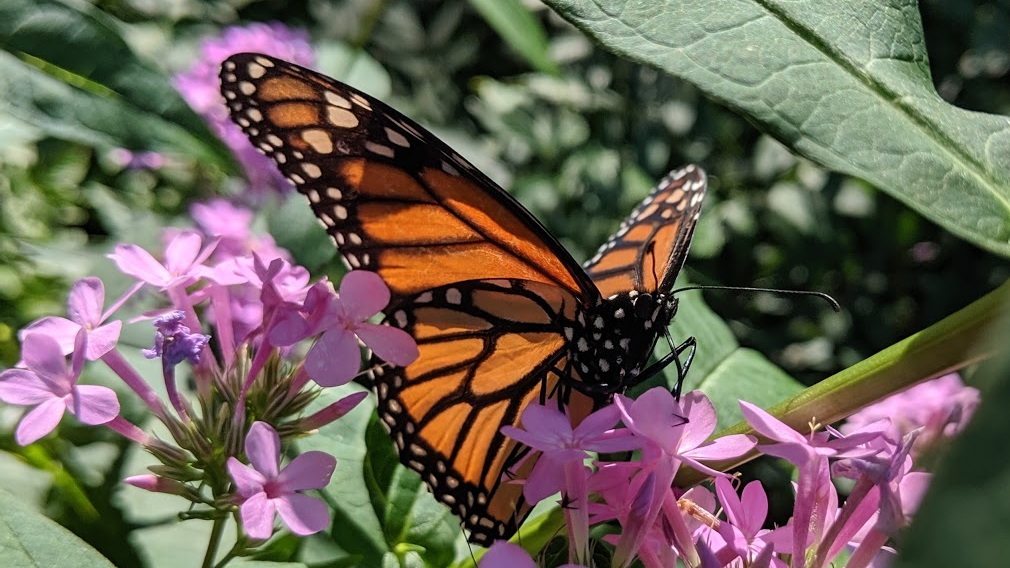Monarch Madness: From caterpillar to pupa to butterfly
‘Jeana’ phlox is frequented by Monarch butterflies in The Big Little Garden
Monarch pupa on Asclepias tuberosa (milkweed)
It’s been a glorious year in The Big Little Garden with seemingly endless daily revelations and magical moments. Like today - I was mere inches away from an Asclepias plant (milkweed) that was host to a Monarch butterfly chrysalis. We hovered all day yesterday and and early this morning, cataloging minute changes as the chrysalis turned from lime green to deep purple/gray. Barely an inch long, the chrysalis became transparent, revealing the gorgeous Monarch within, then at 11:05 a.m. (when I wasn’t looking!) burst open and the butterfly emerged (pics below). Moments like these are important reminders of the magical, mystical, life-giving power of our gardens. And of the importance of eliminating (or at least minimizing) the use of pesticides. The latter are not compatible with the garden’s Daily Wonder that unfolds before our eyes.
The Missing “Windshield Effect”
On a related note, we spent a week up at our lake house in the Adirondacks over Labor Day. It’s a six hour drive from southern New Hampshire. On the way up, we were half way into our journey and approaching Rutland, VT before we experienced the first “bug splatter” on the windshield. After six hours of driving through back roads and highways, passing miles of goldenrod and other native grasses and wildflowers like Queen Anne’s Lace, the windshield and front grille were mostly insect-free when we reached our destination. It was a notable event. And distressing.
In contrast, we both remember our childhood trips in the car with family. We could barely drive 10 miles down the road to Grandma’s house without having to stop at a gas station to clean the windshield in the summer time. If this isn’t a wake-up call to stop the use of pesticides, I don’t know what is.
Back to the Monarchs
Even though New England’s Monarch butterfly populations were weaker this year due to our cold, wet spring (according to Monarchwatch.org), the encouraging news is that their populations are slowly recovering in their wintering grounds in Mexico. This is the result of educational programs and collaboration with agricultural groups and farmers along the Monarch’s migration route. Specifically, the reduction of chemical pesticides to control weeds in mid-western corn and soy fields and the promotion of the Monarch’s ONLY LARVAL HOST PLANT: milkweed.
Milkweed is the only plant upon which the female butterfly will lay her eggs and is the only plant that the newly hatched caterpillar will eat. Unlike most other caterpillars, Monarchs can consume the toxic milkweed leaves, which in turn, make them toxic to potential predators. Birds and mice have learned to avoid them and for the most part, leave them alone. You can read more about this incredible interaction here
We have three varieties of native asclepias (milkweed) here in New England. Please let me know if you are interested in milkweed seeds or seedlings. I will harvest literally hundreds of seeds from their exploding seed pods this fall. And will have dozens of seedlings popping up all through the garden next spring.
Garden Creatures Prefer a Bit of Mess
While we are weeks away from “Fall Cleanup" activities, I want to encourage everyone to take a chill pill and try to relax a bit more and really enjoy the daily changes happening in the garden. Birds, butterflies, bees, insects and all critters need the habitat supplied by our backyards and woods. Our obsessive tidiness reduces their chances of survival through the seasons. The Monarch chrysalides that are in your garden NOW, will pupate soon and it’s this generation that will likely make the long migration journey to Mexico by the end of October. It would be a shame to inadvertently destroy their habitat and toss them to the curb for weekly trash pickup.
Chrysalis #1
We have been watching 3 different chrysalides (yes, that’s the plural of ‘chrysalis’) and as described above, the first one emerged today. After about three hours of drying his wings, he finally took flight!
Here are a few pics of the phases of his life since August 19th. First the caterpillar, then its chrysalis from Day 1-20 (today).
Read more and watch videos of Monarch butterflies in The Big Little Garden here.














